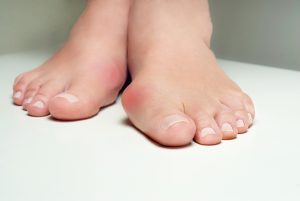Dr. Brian Nagy | January 23rd, 2018
Posted In: Foot Problems, General Foot Pain
 If you develop a bump on your foot, near your big toe, it’s a logical assumption to think you’re developing a bunion. Even if you think that you know what’s causing your foot problem, you should make an appointment with your trusted podiatrist. There are several other foot conditions that can cause lumps to form on your foot.
If you develop a bump on your foot, near your big toe, it’s a logical assumption to think you’re developing a bunion. Even if you think that you know what’s causing your foot problem, you should make an appointment with your trusted podiatrist. There are several other foot conditions that can cause lumps to form on your foot.
A bunion is a lump of bony tissue on the outside of the joint between your big toe and the rest of your foot. It’s caused by the misalignment of your toe and the metatarsal bone in your foot.
The bump causes excess friction on the side of your foot, leading to calluses and corns. It can also cause foot pain, especially when you walk and put pressure on the misaligned bones, tendons, and muscles.
There are a variety of treatments available for bunions, depending on the severity of your foot problem. Mild bunions often resolve with a change of footwear, orthotics, and physical therapy to gently realign your toe. In more severe cases, you may need surgery to realign your bones or to remove an excess bony tissue that has formed on your joint.
Arthritis of your big toe joint causes swelling that can look similar to a bunion on the side of your foot and also cause foot pain when you walk or put pressure on your foot. A foot problem called hallux rigidus develops, causing bone spurs to develop on the joint. This deformity leads to irritation and inflammation of the skin, which makes the bump look even more bunion-like. Arthritis is often treated with anti-inflammatory medication and the application of ice.
A ganglion cyst is a cyst or non-cancerous tumor that forms on a joint. While these cysts are more common on your hands or wrists, they can also develop on your feet and ankles. Ganglion cysts are linked to joint trauma and often cause pain when you move the affected joint. Ganglion cysts are often softer to the touch than a bunion. You should not try to pop or remove a cyst on your own. Make an appointment for diagnosis and professional medical treatment.
Gout is a specific form of arthritis that develops when high levels of uric acid cause crystals to develop in your joints. Gout commonly affects the feet and toes. It causes your toe to become swollen and red, which leads to it being mistaken for a bunion. Gout causes a significant amount of pain and decreased mobility. Gout is typically treated with medication to reduce the inflammation and pain while also clearing the extra uric acid from your system.
When your bursa, the sacs of lubricating fluid in your joints, become irritated and inflamed, you develop a condition called bursitis. It causes swelling, redness, and pain in the affected joint and can lead to decreased mobility. Bursitis is typically caused by repetitive use or an injury. The condition is painful and can lead to calcium deposits forming in the joint, which amplifies the pain. Bursitis is often treated with rest, ice, and anti-inflammatory medication.
Misalignment anywhere in your body can lead to radiant pain. For example, if your ankle is misaligned, all the small muscles and tendons in your foot will be affected, which could pull the other bones out of correct alignment. This can lead to inflammation and pain in your toes, the arch of your foot, and up through your legs, knees, and hips. Alignment issues are easily treated with HyProCure®, the minimally invasive placement of a small titanium stent in the natural space between the ankle bone and heel bone to keep the foot properly aligned.
The best way to identify the cause of your foot pain is to make an appointment with your trusted podiatrist. Our doctor offers thorough examinations to diagnose the cause of your foot problem and provide effective treatments to relieve your pain and heal the underlying cause. At Nagy Footcare, our best day is the day when you wake up with no foot pain.
« Walking Tips for Anyone Experiencing Foot Pain While Running | How to Help Your Foot Pain While on the Job »